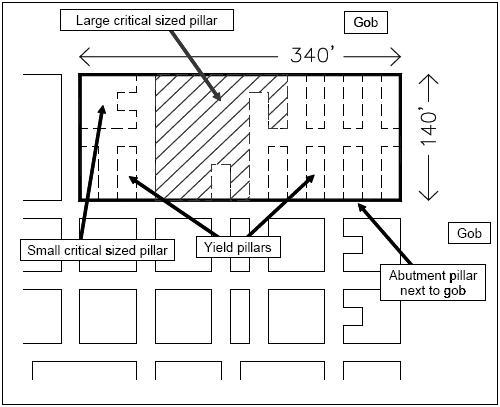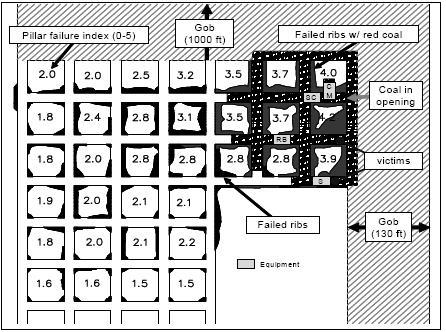
Source of information: http://www.cdc.gov/niosh/mining/pubs/pdfs/cmbpc.pdf
Coal mine bursts have represented a major hazard for U.S. mining operations for more than 90 years. During this time, many prevention controls have been developed and tested. This paper reviews 11 prevention control techniques. Although coal mine bursts are not common events in most underground coal mines, their occurrence almost always requires a change in mining practice. Over the many years of dealing with these hazards, specialized requirements for layouts and novel extraction sequences have been developed on a site specific basis. The keys to mitigating risks are to properly assess the coal burst hazards and to possess the knowledge and skills to prevent or remediate their occurrence.
Coal bursts 1 are violent failures of ribs, roof or floor in underground coal mines. This hazard is not new to the US mining industry. Coal bursts are known to occur in complex ways and often under unique sets of conditions. This has made them extremely difficult to control or forecast. As one might expect, there have been many engineered prevention controls proposed to mitigate the devastating effects of these dynamic and violent failures. Over the years, specialized requirements for mine layouts and novel mining sequences have been developed on a site specific basis to more safely extract burst prone coal. While none of these prevention controls should be considered a “stand alone” design method, they are extremely useful when an operation is assessing its coal burst hazard and evaluating controls to help mitigate the associated risks. A coal burst risk assessment calls for engineers, managers and safety professionals, especially those who might deal with this hazard on a regular basis, to understand how to use these historically proven prevention controls. Coal mine burst prevention controls tend to focus on qualitative solutions to very specific conditions. Operators need to consider the prevention control that most closely relates to the fundamental factors that are capable of producing coal burst hazards at their respective mines. Also, many of the following prevention controls can be thought of as recommendations or definition of things to do or not to do. They rarely provide methodologies to quantify actions lying between these two end-points. It should also be noted that this study did not discuss remediation controls, i.e., destressing.
Early on, mining practitioners noted that uniform pillar sizes are less likely to produce burst prone conditions than layouts with a range of pillar sizes (Holland and Thomas, 1954). Reeves (1954) expressed apprehension in allowing abutment pillars to occur next to the gob. Large pillars are stiffer, and tend to deform or converge much less than their small chain pillar counter-parts. These stiffer structures tend to gather load. If they are then mined, there is a high potential for violent failure due to the larger pillar’s greater energy storage capacity. Uniform pillar sizes are generally considered to be more advantageous during room-and-pillar mining; however, other controls may be necessary to fully mitigate coal burst hazards. An example of this occurred in 1982 at the Olga Mine in southern West Virginia (Campoli, et al., 1987). Two miners were fatally injured while mining a pillar that contained gob on two sides. At the time of the accident, the pillar had been split into a number of different size pillars, including one large critical–size pillar, one smaller critical–size pillar and nine yield pillars (figure 1). The large critical-size pillar violently burst as it was being mined.
When coal pillar bursts first began to occur in eastern Kentucky (Bryson, 1936), many of them were occurring along the retreating pillar line where uneven pillar lines were observed. Holland and Thomas (1954) realized that this practice was dangerous and issued a recommendation to avoid “pillar–line points”. These section-wide mine plans can contribute to coal mine bursts when overlapping abutment pressures from converging gob lines cause excessive stress conditions in the pillar-line point area. The C-2 Mine bursts on November 20, 1996 that injured 6 miners, two fatally, provides one recent example where converging pillar lines were thought to be at least.

Figure 1. A larger, critically–sized pillar surrounded by smaller,critically-sized pillars and yield pillars near a gob acts to concentrate stresses and pose an increasedrisk for coal bursts.
partiallyresponsible for the event (figure 2). It should be noted that there may be limits to the width of a uniform extraction front. Notely (1984), writing aboutcoal bursts at the Springhill Coal Mine in Nova Scotia, Canada, provides evidence of this. Early in 1958, a series of bursts occurred at the mine that was thought to be causedby the staggered mining of three adjacent longwall faces. In aneffort to rectify this problem, the mine operator altered the mining of these three longwall panels until one large mining front was formed. Unfortunately, this alignmentwas associated with the devastating October 24, 1958 Springhill coal.

Figure 2. Map of the conditions observed by MSHA personnel after the C–2Mine burst where converging pillar extraction fronts concentrated stresses at pointsof intersection.
mine bursts, where 74 miners were fatally injured. In this case, a very widecave zone may havefailed catastrophically, causing the fatal burst condition.
When pillar extraction occurs under excessive stresses and the pillars are critically-sized chain pillars, it is sometimes advisable to take a bump–cut of approximately 20 ftin length driven from the center of the rib toward the pillar core. The name was given to this individual cut sequence because of the frequent occurrence of audible seismic events that sound like thumps or bumps. The origin of the bump-cut method is unknown, but examination ofold mining maps in the central Appalachian CoalFields show that it was in use bythe 1960’s. The bump-cut should be the first cut that is extracted from a pillar during retreat mining. Typically this cut is made in the center of a critically-sized pillar so thatthe remaining coal, left on either side of the bump-cut, will readily yield. Ifthe pillaris highly stressed, the bump-cut can act to release the loadin a controlled fashion to adjacent pillars. In this way, a bump–cut is a means of destressing thepillar prior to full extraction with the continuous mining machine. The Deer Creek Mine in Utah (figure 3) has used the bump-cut method to destress a number of highly–stressed critical pillars along one of its gate entry developments (Iannacchione and Zelanko, 1995)...
The findings and conclusions in this paper have not been formally disseminated by the National Institute for Occupational Safety and Health and should not be construed to represent any agency determination or policy.
Anon (2007). International Longwall News. November 22, 2007.
Bryson, J.F., (1936). Method of Eliminating Coal Bumps or Minimizing Their Effect. Transactions of the American Institute of Mining, Metallurgical and Petroleum Engineers 119:40–57.
Campoli, A.A., Kertis, C.A. and Goode, C.A., (1987). Coal Mine Bumps: Five Case Studies in the Eastern United States. U.S. Bureau of Mines IC 9149, 34 pp.
Campoli, A.A., Oyler, D.C. and Chase, F.E., (1990a). Performance of a Novel Bump Control Pillar Extracting Technique During Room–and–Pillar Retreat Coal Mining,” US Bureau of Mines 9240, 40 pp.
Campoli, A.A., Barton, T.M., Van Dyke. F.C. and Gauna, M., (1990b). Mitigating Destructive Lonwall Bumps Through Conventional Gate Entry Design. U.S. Bureau of Mines RI 9325, 38 pp.